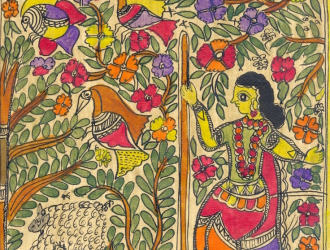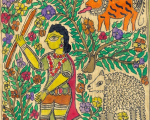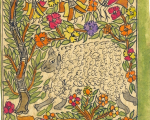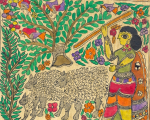Madhubani or Mithila art gained prominence in the early 1970s when the rural women of Mithila district of Bihar began to draw their wall paintings on clothes and paper with acrylic and watercolours. Madhubani paintings use elaborate decorative patterns and fertility motifs in their art. Representations of lotus, bamboo groves, fish and snakes in unison, and twin birds are some of the motifs we find in Madhubani. The styles in Madhubani paintings are identified by the caste names, and the Brahmin and Kayastha are the leading styles. Kiran Devi, who drew the story of 'The Shepherd and the Lion' depicted here, practices her art in the Brahmin style. Kiran Devi fills ups every frame with flowers, leaves, plants and birds in lavish colours and the main characters of the story event are at the centre. One can see the stylised eyes and garments that adorn all the characters, creating an effect of evenly distributed decorative drawings. Kiran Devi does not depict the emotions of the characters. The emotions of the characters submerge in the brightly coloured surfaces of the paintings. Storytelling in Madhubani art can be varied, but Kiran Devi's special quality lies in her use of scenes to tell the story. Successive unfolding scenes indicate the actions happening in the story without the emotions, moments, drama, or actions dominating the narration.





Madhubani: Tale of the Shepherd and the Lion
in Image Gallery
Published on:

M.D. Muthukumaraswamy
M.D. Muthukumaraswamy is a Tamil writer, Director of National Folklore Support Centre, Chennai, and a Consultant at Sahapedia.











